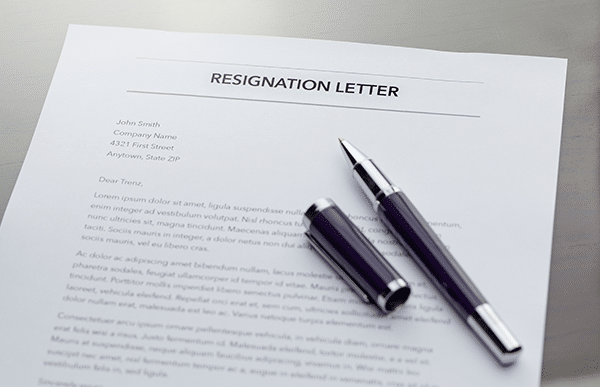Resignation letters are a formal way to inform an employer of your intention to leave a job. It’s a professional courtesy that assures a seamless transfer for both you and your employer, not just a formality. It is important to carefully draft this document because it will be a part of your employment record and may have an impact on your professional reputation. In this article, I’ll offer a thorough guide for writing a resignation letter. You must understand how to write a resignation letter, regardless of the reason behind your departure from your current position—personal, professional, or other.
I will provide you with useful guidance, pointers, and templates so that you may approach this frequently difficult chore with professionalism and confidence.
Let’s examine the essential elements of a resignation letter, explaining their significance and appropriate strategies.
We’ll go over everything you need to know, from understanding the fundamentals to developing an effective message.
To make sure your resignation letter makes a good impression, we’ll also offer sample templates and dos and don’ts.
After reading this, you will possess the skills and resources necessary to compose a resignation letter that exhibits your expertise and appreciation, enabling a seamless departure.
What is a Resignation Letter?
An official letter of resignation is what an employee gives to their employer to officially inform them that they are leaving their present position at the company.
Important information including the employee’s desire to leave, the resignation’s effective date, and occasionally the reason for leaving are usually included.
A resignation letter is essentially a matter of professional etiquette, but it also acts as official documentation of your choice to end your job.
Why is a Resignation Letter Important?
One can not overstate the significance of a resignation letter.
First of all, it removes any doubt by formalizing your choice to quit and giving certainty.
You and your employer must have this information so that you can take the appropriate action to ensure a seamless transition.
Furthermore, it exhibits professionalism and deference to your employer as well as your peers.
A strong final impression from a well-written resignation letter might be advantageous for networking or future references.
Last but not least, it supports preserving a good rapport with your company, which may prove advantageous later on.
Read Also: LETTER OF SUPPORT: How To Write A Letter Of Support
When Should You Submit a Resignation Letter?
Ideally, you should turn in your letter of resignation two weeks or more before the day you want to leave your job. This allows your employer enough time to arrange for a smooth transfer, recruit a successor, and reassign work.
If your job contract, however, stipulates a different notice period, follow those guidelines. To minimize disturbance, carefully consider the scheduling as well, particularly during busy times or fundamental projects.
All things considered, sending in your resignation letter on time shows professionalism and regard for your company and coworkers.
Read Also: Formal Writing: “To Whom It May Concern” Letter Examples and Templates
Components of a Resignation Letter
#1. Header with Contact Details
Provide your complete name, address as of right now, phone number, and email address. Also include the employer’s name, title, business name, and address come next.
#2. Date
Write the resignation letter’s submission date (make sure it matches the format of dates that is typically used in your nation or area).
#3. Salutation
Write the letter to your direct supervisor or the relevant employee of the organization. Begin with an official greeting like “Dear [Supervisor’s Name],” A person’s name is dear to them.
#4. Resignation Declaration
Clearly express your desire to leave the position you are currently in. Provide the date on which your resignation will take effect, which is normally two weeks after the date of submission.
#5. Reason for Resigning
Please include a brief explanation of your resignation, if at ease. Remain professional and refrain from disturbing the business or your coworkers.
#6. Expressing Thanks and Recognition:
It helps to show gratitude for time spent in your previous job. It would allow for a good farewell and possible referrals.
#7. Concluding Remarks
Express gratitude once more for the chance to work for the company. Offer best wishes for the business’s ongoing prosperity.
#8. Signature
Sign off on the letter with your typed name and a formal closure (such as “Sincerely,” “Best regards,” etc.).
Adding a handwritten touch by signing your name in ink above your typed name is one way to make your resignation letter seem more professional and respectable while still effectively communicating your decision to leave.
Resignation Letter Templates
#1. General Resignation Letter Template
[Your Name]
[Your Address]
[City, State, ZIP Code]
[Email Address]
[Phone Number]
[Date]
[Recipient’s Name]
[Company Name]
[Company Address]
[City, State, ZIP Code]
Dear [Recipient’s Name],
I am writing to formally resign from my position at [Company Name], effective [last working day, typically two weeks from the date of the letter].
I have enjoyed my time at [Company Name] and appreciate the opportunities for professional growth and development that I have experienced during my tenure here. However, after careful consideration, I have decided to pursue another opportunity that aligns more closely with my long-term career goals.
I will ensure a smooth transition of my responsibilities before my departure. I am grateful for the support of the team and the guidance of management during my time here.
Please let me know how I can assist during this transition period. Thank you again for the opportunity to be a part of [Company Name], and I wish the team continued success in the future.
Sincerely,
[Your Name]
#2. Template for Career Advancement
Your Name]
[Your Address]
[City, State, ZIP Code]
[Email Address]
[Phone Number]
[Date]
[Recipient’s Name]
[Company Name]
[Company Address]
[City, State, ZIP Code]
Dear [Recipient’s Name],
I am writing to formally resign from my position at [Company Name], effective [last working day, typically two weeks from the date of the letter]. This decision comes as I have been presented with a new opportunity that aligns with my career advancement goals and offers significant professional growth.
During my time at [Company Name], I have gained valuable experience and skills that have contributed to my professional development. I appreciate the support and opportunities provided by the team and management.
I am committed to ensuring a smooth transition and will assist in training a replacement to take over my responsibilities. Please let me know how I can be of assistance during this transition period.
I am grateful for the experiences and relationships I have gained at [Company Name] and look forward to applying my skills and knowledge in my new role.
Thank you for understanding my decision, and I wish the company continued success in the future.
Sincerely,
[Your Name]
#3. Resignation Letter For An Unfit Role
[Your Name]
[Your Address]
[City, State, ZIP Code]
[Email Address]
[Phone Number]
[Date]
[Recipient’s Name]
[Company Name]
[Company Address]
[City, State, ZIP Code]
Dear [Recipient’s Name],
I am writing to formally resign from my position at [Company Name], effective [last working day, typically two weeks from the date of the letter]. After careful consideration, I have realized that the role is not the right fit for me and does not align with my career objectives.
I appreciate the opportunities I have had at [Company Name] and the experiences gained during my tenure. However, it has become clear that pursuing a different career path will better serve my professional aspirations.
I am committed to ensuring a smooth transition and will assist in any way possible to transfer my responsibilities effectively. Please let me know how I can support this transition.
I want to express my gratitude for the support and guidance provided by the team and management. I have learned valuable lessons during my time here.
Thank you for understanding my decision. I wish [Company Name] continued success in the future.
Sincerely,
[Your Name]
#4. Template For Advance Notice
[Your Name]
[Your Address]
[City, State, ZIP Code]
[Email Address]
[Phone Number]
[Date]
[Recipient’s Name]
[Company Name]
[Company Address]
[City, State, ZIP Code]
Dear [Recipient’s Name],
I am writing to formally announce my resignation from my position as [Your Position] at [Company Name], effective [last working day, typically two weeks from the date of this letter]. I wanted to provide ample notice to ensure a smooth transition and to assist in any way I can during this period.
I have enjoyed my time working with [Company Name] and appreciate the opportunities for growth and development that I have experienced here. However, I have decided to pursue a new career opportunity that aligns more closely with my long-term career goals.
I am committed to ensuring a seamless transition of my responsibilities. Please let me know how I can assist in training my replacement or transferring my duties to other team members.
I want to express my gratitude to the entire team and management for their support and guidance throughout my tenure at [Company Name].
Thank you for understanding my decision. I look forward to working with you during this transition period and wish [Company Name] continued success in the future.
Sincerely,
[Your Name]
#5. Resignation letter template for pursuing a new role with a shorter commute
[Your Name]
[Your Address]
[City, State, ZIP Code]
[Email Address]
[Phone Number]
[Date]
[Recipient’s Name]
[Company Name]
[Company Address]
[City, State, ZIP Code]
Dear [Recipient’s Name],
I am writing to formally resign from my position as [Your Position] at [Company Name], effective [last working day, typically two weeks from the date of this letter]. After careful consideration, I have decided to pursue a new opportunity that offers a shorter commute, allowing me to achieve a better work-life balance.
I have appreciated my time working with [Company Name] and am grateful for the experiences and professional growth I have gained here. However, the opportunity for a role closer to home aligns more closely with my current circumstances and personal goals.
I am committed to ensuring a smooth transition of my responsibilities before my departure. Please let me know how I can assist in training my replacement or transferring my duties to other team members.
I want to express my sincere gratitude to the entire team and management for their support and collaboration during my time at [Company Name].
Thank you for understanding my decision. I look forward to remaining in touch and wish [Company Name] continued success in the future.
Sincerely,
[Your Name]
Dos and Don’ts of Writing a Resignation Letter
Dos:
#1. Keep a Professional Tone
Make sure your resignation letter has a polite, professional tone. Avoid using slang and casual language.
#2. Be truthful but strategic
Be truthful yet tactful if you decide to give a reason for your resignation. Unfavorable comments should be avoided. Concentrate on helpful criticism.
#3. Observe the company’s guidelines
Comply with any special instructions or protocols provided in your job contract or manual. Before submission, verify that the notice periods and processes in your resignation letter adhere to the company’s policies.
Don’t:
#1. Point fingers or criticize
Don’t include criticism in your resignation letter about your boss, coworkers, or business policies.
It is bad for your reputation and professional ties to hold people accountable for your resignation.
Wait to formally submit your resignation letter before posting an announcement on social media.
Social media resignations are unethical and might lead to needless rumors and misunderstandings.
#3. Burn Bridges
Refrain from airing your issues or frustrations in your resignation letter.
To maintain professional relationships and make a lasting impression, always speak in a courteous and upbeat manner.
If you abide by these dos and don’ts, you can make sure that your resignation letter is accepted and that it facilitates a smooth transition for both you and your employer.
Conclusion
We’ve gone over all the important topics for writing a resignation letter in this tutorial. We’ve talked about how important this agreement is to keeping professionalism, enabling a seamless transition.
Important elements like being grateful, keeping a professional demeanor, and adhering to corporate standards shouldn’t be taken for granted.
We encourage you to use the supplied instructions to construct your resignation letter if you’re thinking about leaving your current job. It shows professionalism to take the time to write a well-thought-out resignation letter, and it guarantees that your exit will be treated with deference and civility.
Recall that leaving your position is a big decision, and how you announce it matters. You can make a lasting impression, open doors for future chances, and keep important professional contacts by writing a resignation letter that is well-received.
I wish you well in your future pursuits and a smooth and successful resignation process.
- EMPLOYEE RESIGNATION LETTER: Format, Examples & Guide
- PAYOFF LETTER: What Are They and How Are They Used
- HOW TO WRITE AN EMAIL: Tips and Examples on Writing Professional Emails
- LETTER OF EMPLOYMENT: Meaning, How to Write It & 20+ Free Samples
- How To Write A Professional Resignation Letter






